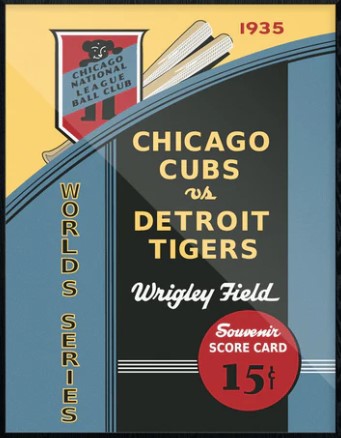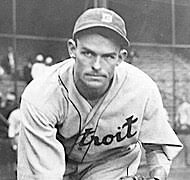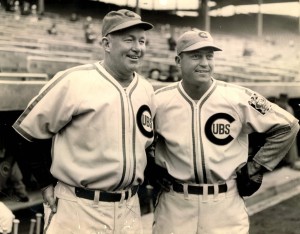|
Pivotal World Series Moments
Goose Gets Series-Winning Hit
1935 World Series Game 6: Detroit Tigers @ Chicago Cubs
After the Cubs won the first game of the Series, the Tigers won the next three. Facing elimination, Chicago won Game 5 3-1 behind the pitching of Lon Warneke for six innings and Bill Lee for the last three innings
The Series moved back to the Motor City for Game 6. Detroit player-manager Mickey Cochrane chose righthander Tommy Bridges, the winner of Game 2. Chicago player-manager Charlie Grimm chose southpaw Larry French, the loser in Game 3.
Tigers Miss Greenburg
The Tigers were hampered by the loss of star 1B Hank Greenberg, who missed the last three games with a sprained wrist incurred while sliding into the plate. Hank was irritated by those who suggested he could have played in those games, giving it "the old college try."
"What good would it have done for me to play when I couldn't catch a ball or swing a bat," said Hammerin' Hank. "Why should I penalize the team by staying on a job that somebody else could fill better?" Infielder Marv Owen replaced him at first base. He could handle the fielding at the new position but wasn't close to Hank in the batter's box.
A standing room crowd of 48,420 that filled every square foot of Navin Field watched the Tigers jump in front in the bottom of the first when Cochrane and 2B Charlie Gehringer singled. Cochrane scored on RF Pete Fox's two-out double.
The Cubs tied the score in the third. SS Billy Jurges led off with a single. After Bridges struckout French, LF Augie Galan singled to second. When 2B Billy Herman poked a single to right field, Jurges raced home with the tying run, but Galan was thrown out at third by RF Pete Fox.
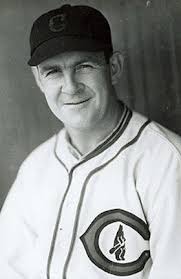  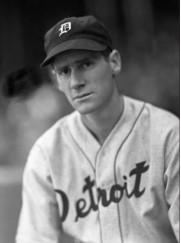 L-R: Larry French, Charlie Gehringer, Marv Owen Detroit retook the lead in the bottom of the 4th. CF Gee Walker and SS Billy Rogell started with singles to put runners on first and second. C Marv Owen bunted toward third base, and 3B Stan Hack nailed Rogell at second while Walker took third. Bridges then helped his own cause by hitting at grounder to Hack, who again got the runner at second while Walker scored. Detroit 2 Chicago 1
The back and forth continued as the Cubs scored two in the top of the fifth to take a 3-2 lead. With two out and French on second, Herman clouted a home run into the left-field bleachers. Chicago 3 Detroit 2
The Tigers tied the game again the sixth with two outs and the bases empty. Rogell smacked a ground rule double down the left-field line when a fan interfered with the ball. Then Owen knocked a single into left to send Rogell home. Chicago 3 Detroit 3
The bottom of the 8th started well for Detroit when Pete Fox hit a ground single between first and single, and Walker sacrified him to second. But French bore down and fanned Rogell and, after walking Owen intentionally, caught Bridges looking.
The Cub ninth started promisingly when Hack drove the ball high and far over CF Gerald Walker's head into the centerfield corner for a three-bagger. He might have gotten an inside-the-park home run but why take a chance with none out? Surely one of the next three batters would drive him in.
But with his infield playing in, Bridges bore down as he had never born down in his life and struck out Jurges on three pitches. In a move that seems unfathomable from today's viewpoint, French hit for himself. He had a single in the game but had struck out in his first and third at-bats. Bridges slipped over two strikes. Then French swung at the next pitch and topped the ball to the pitcher's box. Bridges looked Hack back to third and threw out French.
Up came Galan who hit .314 and led the Cubs in runs scored. The infield fell back. Bridges aimed his pitches at the outside corner to keep the ball away from Galan's groove, which was high and inside. Augie finally reached for one but hit under the ball and lifted a lazy fly toward left field. Goslin came in and snatched it to end the inning with no damage.
The bottom of the ninth started well for the Cubs when Detroit 3B Flea Clifton fanned on a 1-2 pitch. But Cochrane drove a grounder to the inside of second base. Herman made a valiant try, knocking down the ball with his gloved hand but couldn't recover in time to throw out the batter.
Cavaretta later explained why manager Grimm didn't pinch hit for French.
There's been some controversy down through the years about that. Grimm has been second-guessed up and down the line for letting French hit in that spot. But I'll tell you something I don't think many people know about. We had been having trouble with the plate umpire, George Moriarity. Some close decisions had gone against us, and there was a lot of heat coming from our dugout. Finally in around the sixth or seventh inning, Moriarity threw quite a few of our players out of the game. That included some guys who Grimm could have used to pinch-hit. So when that situation cropped up in the ninth, he just didn't have anybody available. I would imagine he would have used a batter for Jurges as well as for French, if he'd had them. But unfortunately we had nobody there.
That brought up Gehringer, the Tigers' leading hitter during the season with a .330 batting average. French worked carefully to him, throwing two balls wide of the outside corner. Then, expecting Charlie to take the 2-0 pitch, French threw one down the middle. Gehringer swung and slapped a fast grounder along the first base line. 19-year-old rookie 1B Phil Cavaretta blocked it and fortunately the ball rolled to the bag. Cavaretta recovered it and tagged first, then threw to second in a futile attempt to double Cochrane. But all he did was hit the runner in the back.
Cavaretta: "Charlie Gehringer came up and, boy, did he hit a shot right at me! It was one of those instances when you see a man swing a bat, and a split second later there's a line drive exploding right on top of you. I played in the big leagues for another twenty years, and I can't remember too many balls that were ever hit harder at me on first base. More in self-protection that anything else, I threw up my gloved hand. The ball tore right on through, and I was just about able to stop it with my bare hand. If I had knocked it down with my glove, I could have gone to second with it and forced Cochrane. But the ball had really stung my bare hand, and I was afraid it might wind up in left field. So I took the sure way out and stepped on first. But that got Cochrane to second."
As Goslin strolled to the plate, he heard the war chant of the pavilions and bleachers: "Yeah, Goose!" The Cub infield was playing back with 2B Herman at least 15' out on the right field grass. The crescendo grew louder as Goslin fouled off the first pitch. Then French jammed him with an inside pitch, but he put the bat on the ball and drove a lazy floater toward right field over Herman's head. It landed just out of the running second baseman's reach. CF Frank Demaree came over and scooped up the ball on a hop and whipped it to the infield. Cavarretta intercepted the throw and relayed the ball home but too late. Cochrane was past the plate by the time the horsehide got to Harnett, and the World Series was over. Detroit had its first World Series victory, and each Tiger was suddenly $2,300 richer.
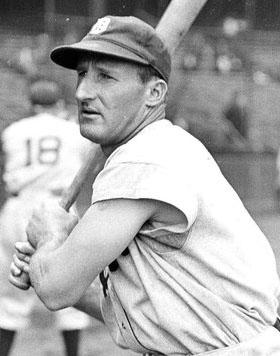 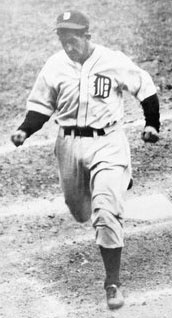 L-R: Goose Goslin; Cochrane scores series-winning run Postgame
Thousands of fans rushed onto the field, milled in front of the Detroit dugout and kept calling for Goslin. They were still there, yelling for him, when he left an hour later.
References The October Heroes: Great World Series Games Remembered by the Men Who Played Them, Donald Honig (1979) Scott Ferkovitch (I Thought I Never Would Get There: The 1935 World Series. https://sabr.org/journal/article/i-thought-i-never-would-get-there-the-1935-world-series/ |
